Diabetes mellitus is a pathological condition characterized by a violation of metabolic processes (metabolism). This happens due to insufficient production of its own hormone substance insulin, as in type 1 diabetes mellitus, or a violation of its effect on the cells and tissues of the body (type 2 pathology).
The article discusses in detail the main types of diabetes mellitus, the differences in their causes and mechanisms of development, as well as a description of the features of the treatment of patients.
A little about insulin and its role in the human body
Insulin is a hormone produced by the pancreas. The organ is located behind the stomach, surrounded by the spleen and a loop of the duodenum. The weight of the pancreas is about 80 g.
In addition to hormones, the gland produces pancreatic juice, which is necessary for the digestion of lipids, carbohydrates and proteins. The hormone insulin is synthesized by β-cells. They are localized almost over the entire surface of the pancreas in the form of small groups called islets of Langerhans. The islets also contain α-cells, which synthesize the endocrine disruptor glucagon. This hormone has the opposite effect to insulin.
A healthy adult human has about a million of these islets with a total weight of several grams.
Insulin is a protein molecule made up of multiple chains of amino acids. Its job is to absorb glucose (sugar) through the body's cells. Sugar is necessary for a person to get energy. Without them, cells and tissues are unable to perform their functions.
In parallel with the absorption of sugar, insulin also regulates the penetration of amino acids into the cells. Amino acids are considered to be one of the most important building blocks. Another function of insulin is the accumulation of lipids in the body.
Classification of Diabetes
According to the classification of diabetes mellitus, which is generally accepted and used in modern endocrinology, the pathology is divided into the following types:
- Type 1 - insulin dependent (IDDM);
- Type 2 - non-insulin dependent (NIDDM);
- form of pregnancy;
- certain types of diabetes.
The latter option is a group of pathological conditions that differ from each other in their pathogenesis and causes of development. These include hereditary defects at the genetic level on the part of the hormone insulin or insulin-secreting cells, a disease caused by exposure to chemicals and drugs, diabetes as a result of infectious processes, etc.
All types of diabetes are united by hyperglycemia. This is a condition that is manifested by elevated levels of glucose in the blood. The confirmation or refutation of the diagnosis of diabetes is based on the background of the diagnosis of blood sugar values.
1 type
Type 1 pathology (ICD-10 code - E10) is considered to be an autoimmune process leading to the death of insulin-secreting cells. In plain language, such processes are set in motion in the human body in which the body's own defense cells consider pancreatic cells to be foreign and destroy them.
The insulin-dependent type usually arises from a hereditary predisposition, but accompanying provocative factors also play an important role. Statistics show that the presence of a pathology in a child is possible in the following cases:
- if the mother is sick - with a frequency of 2%;
- sick father - 5%;
- sick brother or sister - 6%.

If one of the relatives has the disease, the rest of the family can be healthy although they are at high risk.
The presence of an autoimmune process, that is, antibodies in the body against the pancreas's own cells, occurs in more than 80% of insulin-dependent patients. In addition to the type 1 disease, diabetics often suffer from other autoimmune diseases, for example chronic adrenal insufficiency, diseases of the pancreas, vitiligo, rheumatism.
How is it developing?
Typically, clinical signs of the disease appear when more than 85% of the insulin-secreting cells have already died, but depending on the individual characteristics of the organism, this period can vary in duration. Often occurs in childhood and adolescence. It happens that young patients learn about the presence of the disease even in the period of acute complications, for example, in the ketoacidotic state.
Lack of energy and lack of insulin lead to a massive breakdown of fats and proteins, which explains the patient's weight loss. High blood sugar causes hyperosmolarity, which is manifested by massive urine production and the development of dehydration symptoms. Since there is not enough insulin, the body suffers from hunger for energy, which leads to excessive synthesis of contrasulinary hormones, that is, those that have the opposite effect in relation to the work of insulin.
These hormones include cortisol, glucagon, and somatotropin. They work by stimulating the production of glucose in the body, even though the blood sugar level is already going through the roof.
The massive breakdown of fats leads to an increase in the number of free fatty acids in the blood. This is a trigger for the formation and accumulation of ketone (acetone) bodies, which become provocateurs of a ketoacidotic state. If such a pathology, dehydration and a shift in blood pH to the acidic side continue to progress, the patient can fall into a coma, even death is possible.
symptoms
Type 1 diabetes is characterized by the development of bright symptoms that increase in severity over several weeks. Diabetics complain:
- to the formation of a large amount of urine;
- excessive thirst;
- constant itching of the skin;
- weight loss.
Manifestations of the disease are considered quite specific, but still require differential diagnosis.
Weight loss accompanied by normal or increased appetite is one of the symptoms that distinguish type 1 pathology from other types of diabetes mellitus. The patient is worried about a strong weakness, he cannot do his usual work, drowsiness appears.
The progression of the clinical picture is accompanied by the appearance of an odor of acetone in the exhaled air, abdominal pain, nausea and vomiting, and symptoms of severe dehydration. If the disease occurs at a later age (about 40 years), the symptoms are not as pronounced, and usually the presence of the disease is detected during clinical examination.
type 2
Non-insulin dependent diabetes mellitus (ICD-10 code - E11) is a chronic pathology against which high blood sugar levels occur due to insulin resistance. Later, the work of β-cells of the islets of Langerhans is also disturbed. In parallel with carbohydrate metabolism, the pathology also affects lipid metabolism.
Hereditary predisposition is one of the main causes of type 2 diabetes. When a parent is ill, children get ill 40% of the time. However, heredity alone is not enough, provoking factors are:
- high body weight;
- low physical activity;
- increased blood pressure values;
- high levels of triglycerides in the blood;
- the presence of a born baby weighing more than 4 kg in the past;
- the presence of gestational diabetes in the past;
- polycystic ovaries.
The number of patients with type 2 diabetes is currently increasing. This form of pathology accounts for more than 85% of all clinical cases. Middle-aged and older men and women are sick more often.
How is it developing?
The mechanism of development is based on the fact that insulin resistance occurs, that is, the pancreas produces a sufficient amount of the hormone necessary to transport sugar molecules into cells, but the cells themselves lose sensitivity to this substance. The result is hyperglycemia.
In order to lower the blood sugar level, the gland begins to work at the limit of its capacity. This provokes the depletion of insulin secretory cells.
For the second type of pathological condition, the occurrence of ketoacidosis is uncharacteristic, since even a small amount of the hormone is synthesized by the islets of Langerhans.
symptoms
The disease usually manifests itself in patients older than 40 years. In most cases, the clinical picture is combined with the appearance of pathological body weight, changes in lipid metabolism on blood tests. Associated Symptoms:
- performance is slightly reduced, but not as pronounced as in the first type of disease;
- pathological thirst;
- excretion of a large amount of urine;
- Women can be bothered by itching of the skin in the genital area and perineum;
- rashes appear on the skin that do not heal for a long time;
- Discomfort, numbness and goosebumps on the lower extremities.
pregnancy type
The WHO classification of diabetes mellitus includes the gestational form of the disease (ICD-10 code - O24). It is typical for pregnant women. Diabetes affects 5-7% of patients who give birth. The WHO classification of diabetes and its types contains another name for this type of pathology - diabetes in pregnant women.
If the disease appeared in a woman before the moment of conceiving a child, then during pregnancy it is considered prenatal. At present, the mechanism of development and the causes of the disease are not fully understood. There is data on the role of hereditary predisposition. Risk factors can be:
- physical and psychological trauma;
- infectious diseases;
- diseases of the pancreas;
- Inclusion in the menu in large quantities of carbohydrate-rich foods.

Obstetricians and gynecologists agree that adequate physical activity can reduce the risk of developing any pathology.
The form of pregnancy can manifest itself as a manifestation, that is, a vivid clinical picture, or a violation of glucose tolerance. The pathology, as a rule, disappears on its own after the birth of the baby.
The woman becomes a member of a group of patients at high risk of developing a non-insulin-dependent type of diabetes mellitus over the next 10-15 years.
During childbirth, a woman's body undergoes certain changes associated with the hormonal sphere. This is due to the function of the placenta, which secretes the following hormones:
- chorionic gonadotropin;
- Progesterone;
- estrogens;
- corticosteroids, etc.
All of these hormonally active substances cause the occurrence of insulin resistance. At this stage, hyperplasia of insulin-secreting cells and the release of a large amount of insulin into the blood from the pancreas are observed. The emergence of insulin resistance leads to the fact that the woman's body begins to actively use the metabolites of fats, while sugar is stored to nourish the fetus. Under conditions of a combination of hereditary predisposition to diabetes and the above factors, the disease develops.
symptoms
The gestational type of the disease manifests itself like other types of diabetes, but the symptoms are somewhat less pronounced. A woman may not pay attention to the symptoms, associating their appearance with her "interesting" position. If the clinical picture is pronounced, the pregnant woman can present the following complaints to the attending physician:
- dry mouth;
- constant desire to drink;
- excretion of a large amount of urine;
- increased appetite;
- decreased performance and weakness;
- the appearance of itching and burning in the genital area.
Important! Usually, the disease develops at the end of the second or beginning of the third trimester.
The impact of pathology on the mother and fetus
Chronic hyperglycemia negatively affects both the mother's body and the child itself. Pregnancy can be complicated:
- polyhydramnios;
- late gestosis;
- termination of pregnancy at different times of pregnancy;
- the birth of a child with a large body weight (more than 4-4. 5 kg).
Babies born to a sick mother have a distinctive appearance. Her shoulders are quite broad, the subcutaneous fat is pronounced, the face has a round moon shape. There is marked skin swelling and hypertrichosis. The most serious complications of the disease are the death of the fetus during fetal development and the death of the newborn. As a rule, such conditions occur in the presence of a pregestional form of the disease.

Children born to a sick mother differ from their peers in their large body weight and characteristic appearance.
Specific Types
We are talking about secondary forms of the pathological condition that develop under the influence of chemicals, drugs, infectious processes and other diseases of the endocrine and extra-endocrine sphere.
Diabetes can be caused by the following diseases and conditions of the pancreas:
- organ inflammation;
- mechanical damage;
- removal of the gland;
- neoplasms;
- cystic fibrosis;
- pigment cirrhosis, etc.
Of the chemicals and drugs, nicotinic acid, adrenal cortex hormones, interferons, thyroid hormones and diuretics can contribute to the development of the disease. The list goes on with opiates, rodent exterminating poisons, antidepressants, antiretroviral therapy drugs.
Of the causative agents of infectious diseases, provoking factors are rubella virus and cytomegalovirus.
Features of the treatment
Therapy of the pathological condition is selected individually for each clinical case. The scheme and methods of treatment used depend on the degree of diabetes, its type, the brightness of the clinical picture and the presence of complications. How to determine and confirm the presence of the disease, a qualified endocrinologist will tell you. He gives instructions on the following diagnostic methods:
- general blood and urine tests;
- Analysis of capillary blood for glucose from a finger on an empty stomach;
- blood biochemistry;
- urinalysis for sugar;
- Glucose tolerance test - it is mandatory for all expectant mothers in the period from 22 to 26 weeks of pregnancy;
- Determination of indicators of glycated hemoglobin.
Therapeutic measures include not only taking medications, but also physiotherapeutic exercises, nutritional corrections, teaching the patient self-control.

It is important for loved ones to support the desire of a sick person to reduce the aggressiveness of the pathological condition and achieve compensation.
self control
Patients with diabetes should record their feelings, blood sugar levels and urine sugar levels, as well as data on individual menus and physical activities throughout the day. The entirety of such indicators and their accounting is self-regulation. The purpose of such events is not only to control sugar levels, but also to interpret the results and plan their actions when the numbers exceed the acceptable range.
With normal health, it is important to measure sugar levels at home and record these indicators at least once a day. Every change in well-being requires a clarification of the amount of glucose in the blood several times a day:
- before each main meal;
- some time after food enters the body;
- before the evening rest;
- In some cases, you may need to measure on an empty stomach in the morning.
Glucose in the urine is also measured at home. This requires the presence of express strips. They can be bought in pharmacies. The presence of sugar in the urine indicates that the blood sugar level exceeds 10 mmol / l, since this value is the renal threshold at which glucose molecules enter the urine.
If the patient travels, actively participates in sports or has concomitant diseases, then more rigorous self-control is required.
For the daily comfortable life of a person with diabetes, it is necessary to purchase the following individual devices and devices:
- Glucometer with lancets, test strips and necessary accessories included;
- Express urine strips that measure levels of acetone bodies and sugar;
- tonometer for clarifying blood pressure readings;
- Self-monitoring diary in which all necessary data is recorded.
meal
Correction of individual nutrition is the basis for the treatment of any form of diabetes mellitus. With type 1, by changing the personal menu, you can reduce the load on the pancreas and reduce the amount of carbohydrates fed to the body. In type 2 diabetes, a low-calorie diet can not only achieve the above goals, but also reduce pathological body weight.

Patients are advised to refer to Table No. 9, which may have several options (a, b, c).
Patients must strictly follow the daily calorie intake. It is calculated individually for each patient, depending on weight, age, gender, energy consumption, physical activity, drug therapy used. When feeding patients, it is necessary to limit the intake of carbohydrates and high-calorie foods. Proteins are not only possible but also necessary, fats should be somewhat restricted, especially in type 2 diseases.
Patients need to understand the system of bread units, glycemic and insulin indices of products and calories. Features of the principles of nutrition:
- eat no more than 8 bread units at one meal;
- sweet liquids (soda, tea with sugar, store-bought juice) are prohibited;
- Sweeteners are used instead of sugar, and homemade compotes and fruit drinks are used instead of store-bought juices.
- the number of bread units must be planned in advance, since insulin is administered before the products enter the body;
- Meals should be in small portions but frequent;
- Patients should be given a sufficient amount of fluid - limitations may occur with renal failure or other complications that are accompanied by edema.
In the table you can read more about forbidden foods as well as those that should be eaten without fear.
| The most caloric to limit | Allowed Products | Allowed amount of alcohol (under the terms of use - below) |
|---|---|---|
|
|
|
The possibility of alcohol consumption will be discussed individually. A small amount is allowed if there is compensation for diabetes mellitus, there are no complications and the patient feels normal. Beer and sweet cocktails are prohibited.
Medical treatment
The treatment of IDDM and gestational form is based on insulin therapy. This is the process of introducing insulin-based hormone preparations to replace the lack of its own substance in the body. There are several groups of drugs that differ in the duration of action and the speed of onset of action: ultra-short preparations, short, medium-term hormones and prolonged insulins.
Doctors usually combine two drugs with different durations of action at the same time. This is necessary to create the most physiological conditions for the pancreas.

The medication is administered with insulin syringes, syringe pens or an insulin pump in automatic mode.
Type 2 disease requires the use of hypoglycemic tablets. The main groups are biguanides, sulfonylurea preparations, thiazolidinediones, glinides etc.
The differential diagnosis between types of diabetes mellitus should only be carried out by a qualified specialist. He will also help you choose a therapy regimen, an optimal lifestyle and give recommendations that will allow the patient to achieve compensation as soon as possible.


























